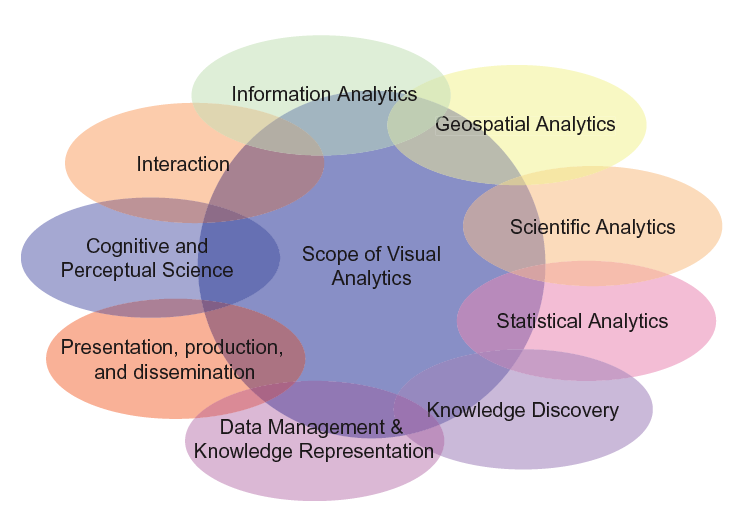Visual Analytics
Visual analytics is the science of analytical reasoning facilitated by interactive visual interfaces. [Thomas and Cook, 2005]
People use visual analytics tools and techniques to synthesize information and derive insight from massive, dynamic, ambiguous, and often conflicting data; detect the expected and discover the unexpected; provide timely, defensible, and understandable assessments; and communicate assessment effectively for action.
Visual analytics is a multidisciplinary field that includes the following focus areas:
- analytical reasoning techniques that let users obtain deep insights that directly support assessment, planning, and decision making;
- visual representations and interaction techniques that exploit the human eye’s broad bandwidth pathway into the mind to let users see, explore, and understand large amounts of information simultaneously;
- data representations and transformations that convert all types of conflicting and dynamic data in ways that support visualization and analysis; and
- techniques to support production, presentation, and dissemination of analytical results to communicate information in the appropriate context to a variety of audiences.
[Thomas and Cook, 2005, 2006]

[Keim et al., 2006]
Visual analytics is more than just visualization and can rather be seen as an integrated approach combining visualization, human factors and data analysis. ... With respect to the field of visualization, visual analytics integrates methodology from information analytics, geospatial analytics, and scientific analytics. Especially human factors (e.g., interaction, cognition, perception, collaboration, presentation, and dissemination) play a key role in the communication between human and computer, as well as in the decisionmaking process.
[Keim et al., 2006]
Visual analytics is the formation of abstract visual metaphors in combination with a human information discourse (usually some form of interaction) that enables detection of the expected and discovery of the unexpected within massive, dynamically changing information spaces. It is an outgrowth of the fields of scientific and information visualization but includes technologies from many other fields, including knowledge management, statistical analysis, cognitive science, decision science, and others.
This marriage of computation, visual representation, and interactive thinking supports intensive analysis. The goal is not only to permit users to detect expected events, such as might be predicted by models, but also to help users discover the unexpected—the surprising anomalies, changes, patterns, and relationships that are then examined and assessed to develop new insight.
This marriage of computation, visual representation, and interactive thinking supports intensive analysis. The goal is not only to permit users to detect expected events, such as might be predicted by models, but also to help users discover the unexpected—the surprising anomalies, changes, patterns, and relationships that are then examined and assessed to develop new insight.
[Cook et al., 2007]
Related Links
- Visual Analytics Digital Library
- SEMVAST Scientific Evaluation Methods for Visual Analytics Science and Technology - Resource on Visual Analytics Evaluation
Visual Analytics @ YouTube
- March 15, 2010 — VisMaster - Mastering the Information Age What is Visual Analytics and why is it important for Europe to fund Research in this new domain?
- December 16, 2008 — Jigsaw Using visualization and visual analytics to help investigative analysis and sensemaking.
- November 03, 2008 — Mikael Jern on Visual Analytics Visual Analytics Center, OECD Explorer
- July 10, 2007 — Why Visual Analytics? - A conversation A series of interviews to some of most known people in Visual Analytics, the science of reasoning through visualization
- December 12, 2006 — Visual Analytics Show segment from "BusinessNOW" on Maryland Public Television
Basic Literature
Books
- J.J. Thomas and K.A. Cook (Eds.), Illuminating the Path: The Research and Development Agenda for Visual Analytics. IEEE Press, 2005.
- Daniel Keim, Jörn Kohlhammer, Geoffrey Ellis and Florian Mansmann (Eds.), Mastering the Information Age – Solving Problems with Visual Analytics, Eurographics Association, 2010.
References
- [Cook et al., 2007] Cook, Kris; Earnshaw, Rae; Stasko, John, Guest Editors' Introduction: Discovering the Unexpected, Computer Graphics and Applications, 27(5):15-19, IEEE, Sept.-Oct. 2007.
- [Keim et al., 2006] Keim, D.A.; Mansmann, F. and Schneidewind, J. and Ziegler, H., Challenges in Visual Data Analysis, Proceedings of Information Visualization (IV 2006), IEEE, p. 9-16, 2006.
- [Thomas and Cook, 2005] J.J. Thomas and K.A. Cook, eds., Illuminating the Path: The Research and Development Agenda for Visual Analytics, IEEE CS Press, 2005.
- [Thomas and Cook, 2006] James J. Thomas and Kristin A. Cook., IEEE Computer Graphics and Applications, 26(1):10-13, January/February, 2006.